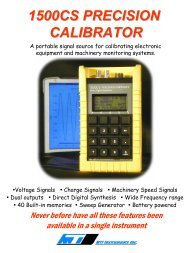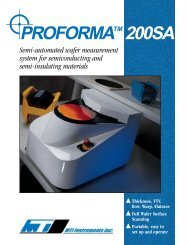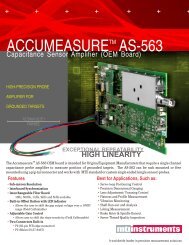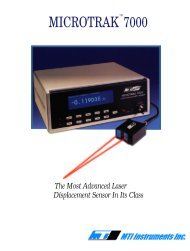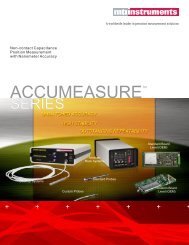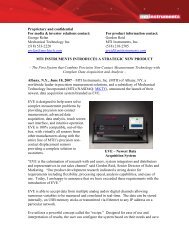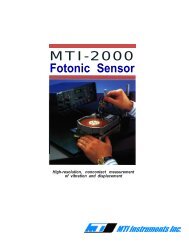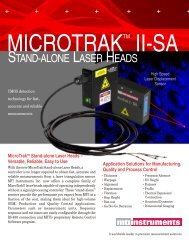APPLICATION NOTE: Laser Triangulation Sensors - MTI Instruments ...
APPLICATION NOTE: Laser Triangulation Sensors - MTI Instruments ...
APPLICATION NOTE: Laser Triangulation Sensors - MTI Instruments ...
You also want an ePaper? Increase the reach of your titles
YUMPU automatically turns print PDFs into web optimized ePapers that Google loves.
The signal from the detector is used to determine the relative distance to the target. This<br />
information is then typically available through an analog output, a digital (binary)<br />
interface or a digital display for processing.<br />
CMOS and CCD type sensors detect the peak distribution of light quantity on a sensor<br />
pixel array to identify target position, whereas, PSD type sensors calculate the beam<br />
centroid based upon the entire reflected spot on an array. Because of this, PSD type<br />
sensors are more susceptible to spurious reflections from changing surface conditions,<br />
which can reduce their accuracy. However, when measuring to ideal matte finishes or<br />
specular targets their resolution is unmatched. CCD and CMOS systems are typically<br />
more accurate over a wider variety of surfaces because only the highest charged pixels<br />
from the reflected beam are used to calculate position. The lower charged pixels are<br />
usually energized by unwanted reflections from changing optical properties of the surface<br />
being measured and can easily be ignored during signal processing. This allows them to<br />
be used in a wider variety of applications. Figure 2 show the signal distribution difference<br />
between CMOS and PSD technology, highlighting the potential accuracy problem<br />
associated with PSD type sensors.<br />
Figure 2: Potential Errors Induced by PSD Type <strong>Laser</strong> Sensor<br />
<strong>Laser</strong> triangulation sensors can also be used on highly reflective or mirror surfaces,<br />
commonly referred to as specular. With these surfaces the typical triangulation sensor, as<br />
shown in Figure 1, can’t be used because the laser light would bounce directly back into<br />
itself. For these cases it is necessary to direct the beam to the target at an angle. The beam<br />
will reflect from the target at an equal but opposite angle and focus onto the detector.<br />
<strong>MTI</strong>I manufactures laser heads specifically designed for specular surfaces or any of our<br />
lasers can be mounted at an angle and operated in the “specular mode” if necessary.<br />
Figure 3 shows the operating principle of a specular laser head.



